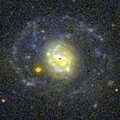Messier 77
| Galaxy Messier 77 |
|
|---|---|

|
|
| Image taken with a 60 cm telescope | |
| AladinLite | |
| Constellation | whale |
|
Position equinox : J2000.0 , epoch : J2000.0 |
|
| Right ascension | 02 h 42 m 40.7 s |
| declination | -00 ° 00 ′ 48 ″ |
| Appearance | |
| Morphological type | (R) SA (rs) b; Sy1 Sy2 |
| Brightness (visual) | 8.9 likes |
| Brightness (B-band) | 9.7 likes |
| Angular expansion | 7.1 '× 6.0' |
| Position angle | 70 ° |
| Surface brightness | 12.8 mag / arcmin² |
| Physical data | |
| Affiliation | LGG 073 |
| Redshift | (3793 ± 10) · 10 −6 |
| Radial velocity | (1137 ± 3) km / s |
|
Stroke distance v rad / H 0 |
(51 ± 4) · 10 6 ly (15.7 ± 1.1) Mpc |
| history | |
| discovery | Pierre Méchain |
| Discovery date | October 29, 1780 |
| Catalog names | |
| M 77 • NGC 1068 • UGC 2188 • PGC 10266 • CGCG 388-098 • MCG + 00-07-083 • IRAS 02401-0013 • KUG 0240-002 • Arp 37 • GC 600 • h 262 • | |
Messier 77 (also known as NGC 1068) is an 8.9 mag bright spiral galaxy with an area of 7.1 '× 6.0' in the constellation Whale . This Hubble-type Sb galaxy is known as a radio galaxy, also known as Cetus A , and has an active galaxy core at its center. They are about 60 million light years apart , so M77 is actually one of the largest spiral galaxies in the Messier catalog. The object is a close neighbor of NGC 1087 .
Halton Arp organized his catalog of unusual galaxies into groups according to purely morphological criteria. This galaxy belongs to the class spiral galaxies with a companion of low surface brightness on one arm (Arp catalog) .
The galaxy Messier 77 was discovered by the French astronomer Pierre Méchain on October 29, 1780 .
High-resolution HST image of the center.
UV recording using GALEX
VLT recording
Web links
- ESO
- ESO: Enchanting spiral galaxy with a lively core, including images and animations
- M77 at SEDS
- Arp Atlas of Peculiar Galaxies
- Seligman Arp
literature
- Jeff Kanipe and Dennis Webb: The Arp Atlas of Peculiar Galaxies - A Chronicle and Observer's Guide , Richmond 2006, ISBN 978-0-943396-76-7
Individual evidence
- ↑ a b c d e NASA / IPAC EXTRAGALACTIC DATABASE
- ↑ a b c d e SEDS : NGC 1068
- ↑ SuW 10.2017 p. 64
- ↑ Seligman





